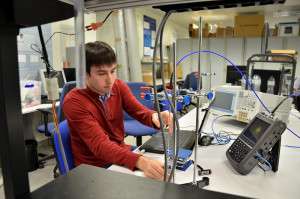New synthetic models with the electromagnetic properties of human tissues

Researchers at the Universitat Politècnica de València (UPV) have developed new synthetic models of human tissues that simulate the electromagnetic properties of different tissues and organs. Known as phantoms, these models may be of interest for the development of new technologies for use in medical screening, as well as for the evaluation of 5G mobile communication devices. The researchers have also devised a methodology for creating these phantoms.
Recently, there has been a growing interest in the use of telecomms devices for clinical diagnosis. Tiny sensors and monitoring units can be incorporated into capsules and ingested orally, recording biological data inside the body and transmitting it to the outside. These devices communicate wirelessly, sending electromagnetic waves through the body, which acts as a transmission medium. A phantom, specifically, is a liquid mixture or a crosslinked polymer (hydrogel) that can be moulded into the shape and size needed in order to simulate a specific organ at the electromagnetic level.
However, further testing and approval is required before they can be put on the market.
The models and methodology developed and patented at the UPV will cut down on the need for such testing. UPV researcher, Narcis Cardona, tells us: "They will help evaluate the transmission of electromagnetic waves in the ultra-wide band frequency range between 3.1 and 10.6 GHz, which will form part of future PANs (personal use), as well as other narrow band networks, such as ISM (industrial, scientific and medical radio bands)."
The new methodology developed at the UPV will allow organs such as the liver, heart, pancreas, colon and cartilage to be simulated on-demand with the correct electromagnetic profile, simulating such as complex relative permittivity, dielectric constant, loss factor and conductivity. For some of these organs, no phantoms currently exist or are set to emerge in the foreseeable future, "not even for a specific frequency," according to Ana Vallés, researcher at the UPV's Centre of Biomaterials and Tissue Engineering.
Provided by Asociacion RUVID


















